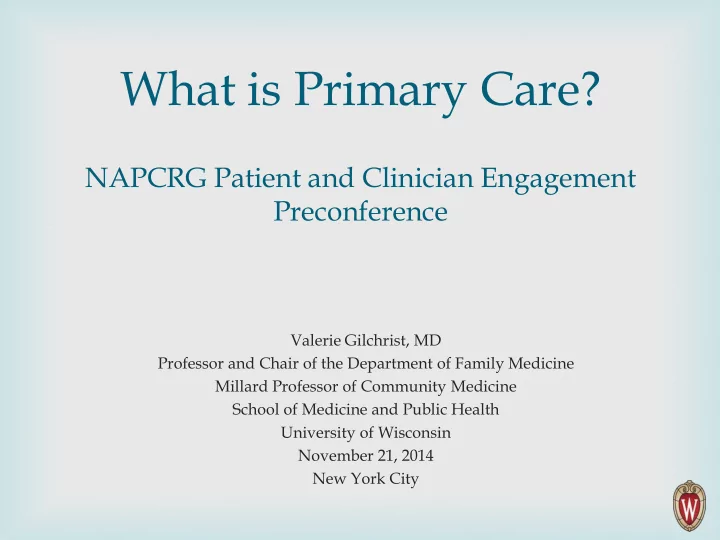

What is Primary Care? NAPCRG Patient and Clinician Engagement Preconference Valerie Gilchrist, MD Professor and Chair of the Department of Family Medicine Millard Professor of Community Medicine School of Medicine and Public Health University of Wisconsin November 21, 2014 New York City
Primary Care Introduction • Exercise as participants define characteristics of PC • Food for thought - Fundamental Flaws and • Persistent Paradoxes Conclusions • (supplementary materials)
Health Care Systems Providers Quaternary Care—Specialized Hospital • Transplants Tertiary Care—In Hospital Care Community Hospitals Secondary Care—Specialists Primary Care
Primary Care Delivers Better Health Outcomes Mortality Morbidity Medication Use Per Capita Expenditures Patient Satisfaction Greater Equity in Health Care Source: B. Starfield, et al., “The Effects of Specialist Supply on Populations’ Health,” Health Affairs (March 2005); W5-97
People do better with primary care. Source: Starfield B, Shi L, Grover A, Macinko J. The Effects of Specialist Supply on Populations’ Health: Assessing the Evidence. http://content.healthaffairs.org/cgi/content/full/hlthaff.w5.97/DC1
(Speed dating for PC)
Questions for our future search 4 questions- 4 lines of 4 dyads Front of the room is top of the line Dyads – 1 minute to answer each question No cross talk just scribe X asks the question then O At 2 minutes X moves up the line, O stays put
Future search visual (same movement for all four groups) round1 round2 round3 round4 O1-X2 O1-X3 O1-X4 O1-X1 O2-X3 O2-X4 O2-X1 O2-X2 O3-X4 O3-X1 O3-X2 O3-X3 O4-X1 O4-X2 O4-X3 O4-X4
Questions from our future search 1. What is primary care? 2. What does primary care do for your community or health care system? 3. What causes you concern about your primary care? 4. What would you tell your legislator or Dean are 2-3 reasons to support primary care?
Results of our future search - 8 people at each question with answers from all 32 Truths – patterns that jump off the page (>70%) Trends – many responses (>50%) Unique ideas – considerations by a few people
Results of our future search - 8 people at each question with answers from all 32 Leader is the person with the most red in their clothes Timekeeper < 30 seconds / response Goal is complete exercise by 10 minutes Go to each person sequentially Each participant gives one answer Start with truths and mark by tick similar responses until no more new truths Do the same for trends and then unique ideas Scribe is youngest person in group Reporter is the shortest person in the group
Summary of future search – report back Truths, Trends and Unique Ideas for #1. What is primary care? 2. What does primary care do for your community or health care system? 3. What causes you concern about your primary care? 4. What would you tell your legislator or Dean are 2-3 reasons to support primary care?
Food for thought…..
Persistent Paradoxes
Primary care physicians provide poorer quality care for specific diseases. Primary care physicians provide better whole person health. Source: Stange & Ferrar: Ann Fam Med 2009
Primary care is so complex no one can do it. Primary care is so simple anyone can do it.
Characteristics of Primary Care Average visit: 3 – 8 problems • Diagnoses: • o other specialists: top 5 = 90% o family doctor: top 25 = 60% total Complexity FM Card Psych Est. total complexity 44.04 42.78 17.49 Duration of visit (min) 15.79 20.47 33.63 Complexity per hour 167.31 125.40 31.21 Sources: Beasley JW. Ann Fam Med 2004;2:405-410. Stange KC. J Fam Pract 1998;46(5):363-8. Katerndahl DA et al. Ann Fam Med 2010;8:341-347
Patients want a continuous healing relationship with a primary care physician. Patients want convenient health care from whomever is available.
Consumers / Patients United States – patients want : 1. Lower premiums 2. To keep their own doctor 3. The latest technology Willing to see a nurse practitioner or physician assistant if an MD is not available. Interest in using innovative health information technologies Interest in using innovative health information technologies • App that reminds you to take medication 40% • App to set and track progress towards health improvement goals 41% • App that enables access to medical records and treatment information 44% • Videoconferencing for sick visits 56% • Self-monitoring device to check condition and send information to doctor • electronically 62% Videoconferencing for follow-up visits 67% •
Fundamental Flaws More is better • Reductionism • Intelligence • Dichotomous thinking • The bell curve • Health and disease •
More is Better . The false positive screening test Over treatment
Reductionism Making attributions to the whole from a part
Intelligence Clinicians intelligence • Patients intelligence •
Dichotomous thinking Specialists/Partialists vs. Generalists
The Bell Curve Measures of central tendency and the outliers
Health, disease and illness Health is more than the absence of disease
Diabetes is diabetes, is diabetes …..NOT It is much more important to know what sort of a patient has a disease than what sort of a disease a patient has. Sir William Osler
Primary Care Patients 40% of new presentations never fit criteria for any • known diagnosis 40% have multiple co-morbid conditions • About half over 65 years have at least 3 conditions • 20% over 65 years have 5 or more conditions • 75% of complaints are self limited • 80% < 65 yrs, 40% > 65 yrs • Sources: Starfield B. Milbank Q 2005;83:457-502 Starfield B. Ann Fam Med 2005;3:215-222
The Mystery
Promoting Health Across Boundaries
Primary Care Integrative Functions --Vertical & Horizontal --Process and Content
Recommend
More recommend